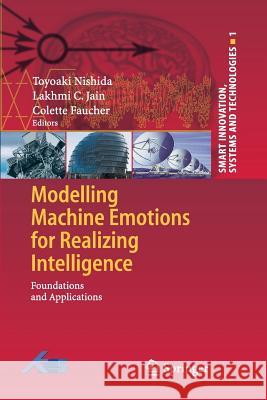Modelling Machine Emotions for Realizing Intelligence: Foundations and Applications » książka
Modelling Machine Emotions for Realizing Intelligence: Foundations and Applications
ISBN-13: 9783642263262 / Angielski / Miękka / 2012 / 228 str.
Modelling Machine Emotions for Realizing Intelligence: Foundations and Applications
ISBN-13: 9783642263262 / Angielski / Miękka / 2012 / 228 str.
(netto: 576,41 VAT: 5%)
Najniższa cena z 30 dni: 578,30
ok. 22 dni roboczych
Bez gwarancji dostawy przed świętami
Darmowa dostawa!
Emotion connects the thought to the body, which is a magnificent biological - vice for sensing and affecting the world. The thought controls the body through emotions. The body affects the thought through emotions. Through this mec- nism, the thought allows the agent to behave intelligently in the complex world filled with a huge amount of dynamic information. The emotion maps a flux of information into a space which the agent is familiar with, enabling her/him to associate ongoing events with past experiences which help to reduce complexity by providing with a nominal solution. Recent findings in brain science suggest that mirror neurons map visual signals into motor signals for the body. This mechanism might permit one to experience the emotion of the other agent just by feeling the motor signals caused by mirror neurons as a result of visual stimuli caused by the other agent's emotional beh- iors. In particular, it might play a significant role in invoking empathy in a social situation. It may not be hard to think about what might happen to emotion-less machines. The emotion-less machines may not be able to accumulate experiences to avoid serious failures. They may not be able to communicate with the humans in an empathetic way.
Emotion connects the thought to the body, which is a magnificent biological device for sensing and affecting the world. The thought controls the body through emotions. The body affects the thought through emotions. Through this mechanism, the thought allows the agent to behave intelligently in the complex world filled with a huge amount of dynamic information. The emotion maps a flux of information into a space which the agent is familiar with, enabling her/him to associate ongoing events with past experiences which help to reduce complexity by providing with a nominal solution.§This research book aims to present recent progress in modeling and synthesizing emotional intelligence. The book consists of ten chapters. The first chapter overviews discussions in this volume. It describes major concepts and issues underlying primitive machineries, appraisal theories, primary and secondary emotions, and image-based thought processes. It discusses how emotional engines might be incorporated into an intelligent system. The nine chapters following this introductory chapter span a wide spectrum of issues concerning emotional models, ranging from a psychological model of priming timing effects to applications to emotionally intelligent agents.











